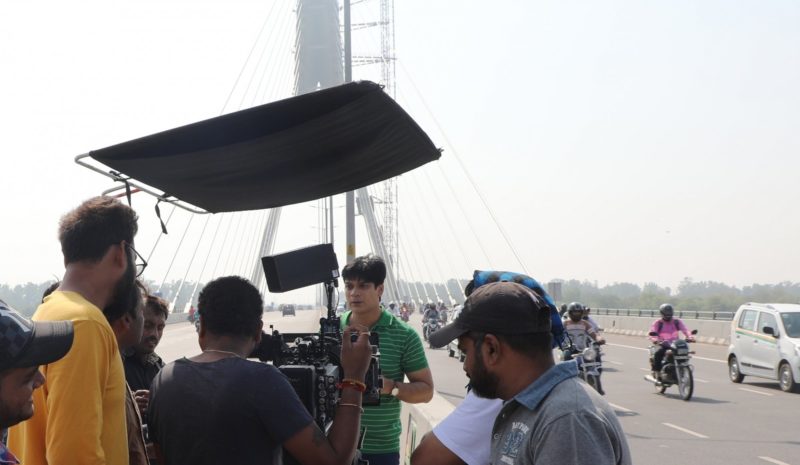Filmmaking: From studios to locations to VFX Suites (Column: B Town)
Actor Imran Zahid
I (IANS) – period. This aspect, broadly speaking, is the available options to shoot where you wish to, not being confined to the four walls of a studio floor.
This aspect, where filmmakers want to come out of the four walls of the studios, is location or outdoor shooting. The process of shooting at locations, moving out of studios, began long back but the process was slow. Technology gave it a major push.
As a rule, almost all black and white era films were shot in studios. If a few directors moved out of the studios at all, it was on some scenic locations of Mumbai. Not only did this moving out take great effort, but also meant the spread of a big crew besides cast members. In that, a shoot which would have taken a couple of days or so, would cost five to seven days when out on streets.
Earlier, whatever the subject of the film, a filmmaker tried to justify it within the parameters of a studio. Studios in those days were huge and had infinite height. There were just bare walls and wooden planks tied with ropes overhead.
It was left for the film’s director, with the help of his art director, to create the world he envisaged for his film’s story within these walls. This breed of art directors was a breed of miracle workers. There are not many people who could point out which sequence of a film was shot in a studio, made possible by the art director. Replicating a location, real or imaginary, was their forte!
Take for example the film “Tere Ghar Ke Saamne”, where the popular song, “Tu jahaan yeh bata iss nashili raat mein”, meant to be at a hill station, was shot in a studio. It was the art director’s triumph. The other song, “Dil ka bhanwar karre pukar”, was shot on the narrow stairs of the Qutub Minar (for the sake of comparison). In the era of heavy cameras and tough lighting, that was the triumph of the trio of the director and the cinematographer aided by the art director; for the camera used to be very heavy in those days and, usually, meant to be static.
In Shakti Samanta’s “Amar Prem”, the song “Chingari koi bhadke”, supposedly shot on Hooghly River with the Howrah Bridge in the background, was actually shot at a studio in Mumbai’s Andheri.
There would be thousands of such examples. However, in the days of black and white movies it was easy as a lot of things were camouflaged for the lack of colour.
The magic makers — the art directors — did not let a filmmaker down in colour films, either, although with colour films, their job became more challenging.
During the studio era, film studios mushroomed all over Mumbai, starting from Jyoti Studios at Nana Chowk to Famous Studios at Mahalaxmi and the Rajkamal at Parel. Dadar and Chembur became studio hubs as many stars lived in the areas nearby like Matunga. Dadar had three studios virtually next to each other — Ranjit, Shri Sound and Rooptara. Chembur boasted of Basant, Asha and RK Studios. As the film production offices started moving northwards, Mehboob Khan started his studio in Bandra. The ones like Mohan, Natraj, Filmalaya, Swati in Andheri, Kamalistan at Chandivali, and Filmistan at Goregaon strived.
The funny thing is people in those days did not mind back projection. If you saw a hero driving a car and saw the scenery moving along, it did not mean the sequence was shot on the roads. It was still a studio and the road and scenery were projected in the background!
Then, the Maharashtra Government set up the multi-facility Film City Studios. Spread over 520 acres, the property has 16 AC and non-AC studios besides 42 outdoor locations. And, what happened was what the wise men always said: Jahan Raja Vyapari, wahan Praja bhikhari. The private studios started running out of business one by one. One after the other, they started giving in to the real developers to cash in and get out.
This closing of studios gave a rise to private bungalows as shooting venues. Some of the best bungalows in Juhu, Versova and Bandra were made available for film shooting. Old time investments brought in new age daily rentals. It was a win win situation for the bungalow owners.
Even these bungalows did not suit all demands of a film script, and this was also the time when the TV Industry started taking wings. This paved the way for smaller, private studios where ready-to-shoot sets were made available, which also met the needs of films when required.
Even during the old studio days, some films needed to be shot outdoors. These were the ones with big vistas — films like “Mother India”, “JIs Desh Mein Ganga Behti Hai”, “Gunga Jumna” and such. You can’t imagine a bullock-cart baraat song like “Gaadi wale gaadi dhire haak re” in “Mother India” or “Aa ab laut chale” in “Jis Desh Mein Ganga Behti Hai” shot in a studio. They were visual delights.
Moving from the studios to streets of Indian cities gradually became a norm. But in the 1960s, some filmmakers planned films across the seven seas. And, these foreign lands were not to be created in studios.
There was Shakti Samanta’s “An Evening In Paris”, Pramod Chakravorty’s “Love In Tokyo”, Pachhi’s “Around The World” as well as “International Crook” and so on. But these were few and far in-between. That was till, shooting abroad became a norm. The scripts were convoluted to justify foreign shootings and some of the biggest producers like Yash Raj Films, Sajid Nadiadwala and Karan Johar proceeded abroad to shoot their films, which could have easily been shot in India. This phase left many in the film industry working on the peripheries — like equipment suppliers, junior artistes and technicians — jobless. For, the crew going abroad was limited to a few people and the rest was outsourced there.
Initially, producer Yash Chopra and later Raj Kapoor chose foreign locations only to shoot songs, while rest of the content was shot locally in India. Others followed this practice.
Among the things that encouraged outdoor shootings, which the makers liked to call ‘actual locations’, was the easier movement of film cameras (much lighter now) as they became easier to carry around. One may remember the Ram Gopal Varma film, “Shiva”, which was fastpaced and full of action shot on actual locations. That was made possible because of a camera called Steadicam. The operator tied the camera around his waist and ran and chased the action. The thing weighed about 40 kilos, and running with it behind the stars in action was no an easy task. The first Steadicam operator in India, who shot “Shiva” was Deep Pal, who earned plaudits for his work.
Now, not only are the cameras lighter but are better equipped in that, you can watch on an attached or remote screen monitor what you are shooting. You don’t need to wait till the negative film you shot on is processed. While, Mumbai was the most popular location to shoot, the makers started venturing out to small towns in the interiors, to places like Uttar Pradesh, where the government offered incentives. Lately, the favourite place to shoot medium range love stories and comedies seems to be Delhi.
Earlier, it was said that the actual film worth taking to the public was made on an editing table. But, now, that ultimate destination has changed. In most cases, it is the VFX studio where the film as one sees it on screen takes shape. Computers do the needful. Sans VFX, you can’t imagine a film like “Fan”, the “Tiger” franchise, “Zero”, “2.0”, “Shivaay”, “Padmavat”, “Race 3”, “Dhoom”, “Total Dhamaal”… the list is endless. While “Total Dhamaal” could have easily been made without special effects, the makers decided to shoot it on Chroma, and only added up a massive price tag by going for VFX. While just about every film goes through VFX, these one required extensive special effects.
Besides films, even some of the stars need these special effects. The stars in their 50s use special effects in just about every frame to spruce up their look by getting rid of wrinkles and dark circles!
@The Box Office
Small is big, as is seen with small or medium-budget films doing well and with films with big stars getting scarcer. The good thing about these small films is that they are content driven and don’t count on a star’s popularity to draw the initial crowds. Also, due to this, admission rates are not jacked up as is done with big-star films to recover huge investments.
* The latest to score with excellent response is “Chhichhore”. The film opened low on Friday but, as the word of mouth spread, the collections took a massive leap and also managed to maintain the momentum after the opening weekend. Earning Rs 7 crore on the opening day and Rs 16 crore on Sunday, the film has closed its first week with an impressive Rs 66-crore haul.
* “Saaho”, expected to establish the “Baahubali” star Prabhas in the Hindi cinema, has not come up to expectations. The film failed to find favour with the audience and the collections (as issued by its makers) don’t quite justify the huge cost. The film has collected about Rs 23 crore taking its two-week total to Rs 136 crore.
* “Mission Mangal” earned about Rs 5.5 crore in its fourth week, taking its total to Rs 194 crore. The film may just about manage to reach the Rs 200-crore mark.
* “Batla House” comes to the end of its run having added just about Rs 1.4 crore in its fourth week for a lifetime total of Rs 89.4 crore.
–IANS
mirani/vnc/ksk
Disclaimer: Validity of the above story is for 7 Days from original date of publishing. Source: AFP.


